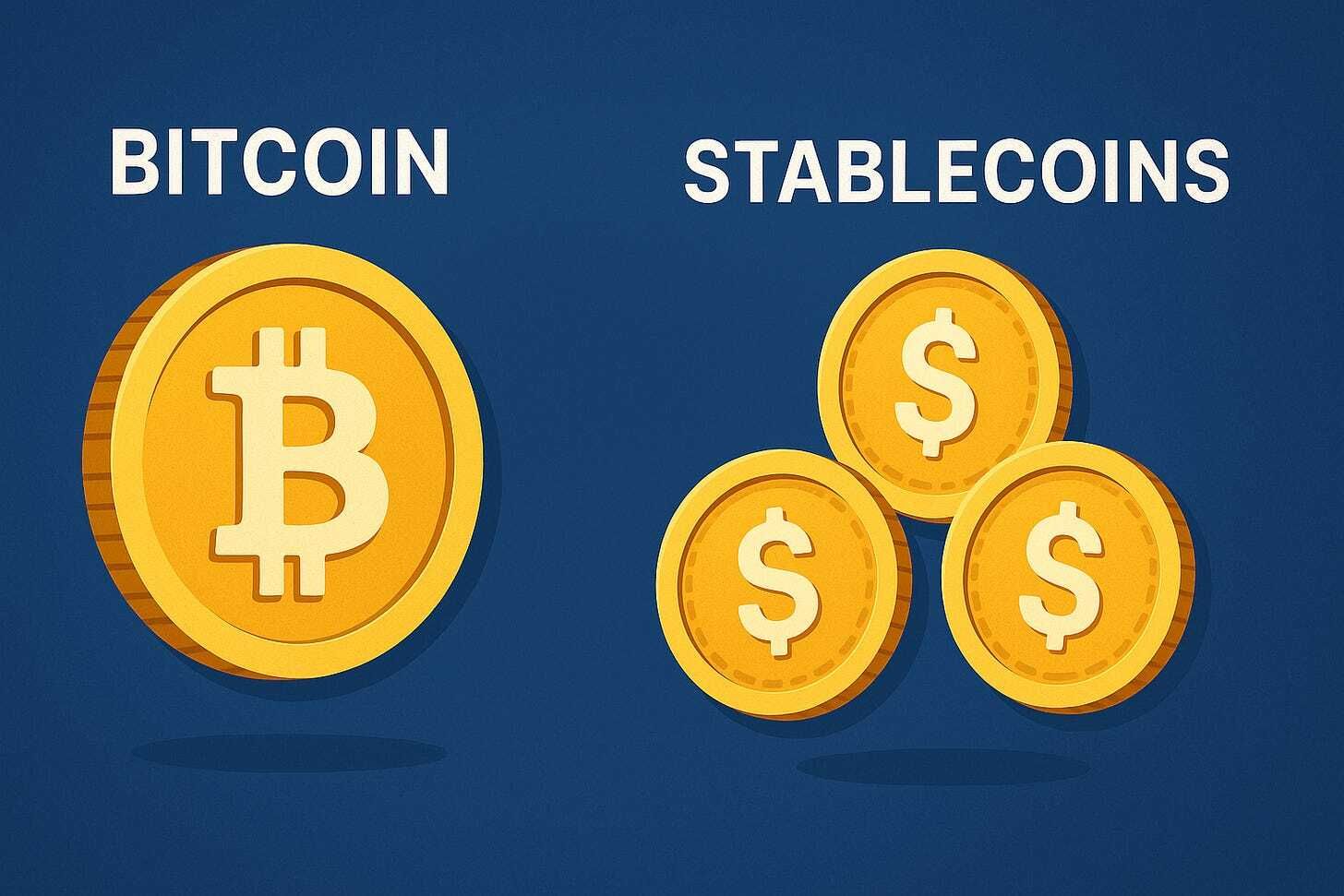
Joël here! 👋
It doesn’t matter whether you’re in Bitcoin only or interested in other digital assets as well.
Inevitably, the question of “What’s the use case of this?” arises at one point.
In my opinion, there is a simple answer with two types of digital assets:
Bitcoin is the base layer of money and a reserve asset of the world.
Stablecoins as the bridge between the fiat and digital assets world.
The rest is just speculation or a wrapper for an already functioning use case in a shiny VC pump or on a blockchain.
Today, I want to focus on the coexistence of these two use cases, why it’s essential to have them both, and what the dangers are with stablecoins specifically.
Stablecoins Are a Necessary Evil
This sounds like an extreme subtitle, but I had to catch your attention!
Contrary to belief in the conspiracy corners of the digital assets community, the stablecoin issuers are doing a good job.
Is there some shady stuff going on with Tether or Circle? Sure! But honestly, if we compare it to the fiat world, these events are peanuts.
Stablecoins are the necessary evil we have to deal with to operate and get on board the digital assets ecosystem.
Sure, you can buy an asset on an exchange with a bank transfer, but if you compare the speed of a swap with a stablecoin compared to the bank transfer, the fiat derivative on a blockchain always wins.
Additionally, stablecoins enable seamless movement and are significantly more efficient within the digital assets ecosystem. If you’re into bridging, swapping, and doing the whole DeFi thing, you actually need stablecoins.
Although many in the ecosystem are aware of the flaws with fiat, we still live in that reality and need a way to move from A to B.
Therefore, stablecoins bridge an important gap between the old and the new.
Issuing a Stablecoin Is an Attractive Business
I couldn’t discuss stablecoins without mentioning their business model and how straightforward it is for them to generate revenue.
Full disclosure, I’m referring to asset-backed stablecoins here. Not any of the algorithmic BS we saw with Terra Luna…
All of these issuers, whether it is Tether (USDT) or Circle (USDC), are issuing a new coin for every dollar deposited in their network.
To maintain that liquidity, they invest the capital in highly liquid assets and yield-returning financial instruments.
The most famous example of this strategy is Tether’s model, where they’ve become one of the largest holders of U.S. Treasury T-bills in the world.
If you want a simple calculation, let’s say they hold $100 billion and invest all of that in 3% T-bills, they return $3 billion a year.
Do that over and over again, and you’ll have a good reserve after a while.
That doesn’t include their active investments in Bitcoin, gold, mining sites, and infrastructure. All of these assets also yield a certain return or can be used as a hedge in times of trouble.
The same applies to Circle, which in the past had issues with banking partners such as SVB, but managed to turn things around.
Stablecoins’ business model is a glitch in the fiat system, as they take on debt risk and in return earn a yield, while offering one of the most efficient on- or off-ramps into the digital assets ecosystem.
But that obviously only works if they are truly backing their currencies. We also saw other examples where it didn’t work.
So far, though, it seems like these stablecoins are too big to fail and solve a lot of issues…
A Bank Account for Everyone Is Already a Reality!
Besides being the cheaper and faster alternative to regular fiat rails, stablecoins also offer a more inclusive way for the unbanked.
Why? Simple: All you need is a wallet and an internet connection.
There are estimates that approximately 2.5 billion people are unbanked. None of these people can walk down the road into a bank branch to get money.
Thanks for reading! This post is public, so feel free to share it.
They either have to adapt to grey market rates, like in Argentina, or use digital assets such as Bitcoin as an alternative.
While I encourage them to use Bitcoin, because the unbanked also live in a fiat world, they prefer using non-volatile assets.
This is where stablecoins come in, and unsurprisingly, they are one of the most widely used financial assets.
Mainly, Tether has emerged as the go-to bank alternative for these 2.5 billion people.
Will Stablecoins Merge With CBDCs?
I’ve so far mentioned the positives of stablecoins, but we also need to factor in the negatives.
In Europe, stablecoins have become a significant concern for the ECB and the Bank of England.
They realized that people are exiting the fiat system and looking for alternatives.
Therefore, they imposed new laws and regulations to make it more difficult for stablecoin issuers to gain a foothold in Europe.
Not surprisingly, there has been pushback by issuers. Tether decided to leave the European market, and Circle agreed to join it, but with limited exposure.
This is one of the most significant risk factors for any digital asset. Regulation and overly protective laws can make life more complicated.
However, I also want to highlight one more aspect: Central Bank Digital Currencies or CBDCs.
ECB Chief Christine Lagarde is very keen on them. She’s pushing the project forward significantly and encourages banks to adopt it as well.
While I don’t want to sound too conspiratorial, it’s a possibility that central banks will knock on the doors of stablecoin issuers and ask to overtake them.
So far, there haven’t been any official comments, but if central banks identify issues in their CBDC implementation - where we ironically see pushback from banks that want to launch their own stablecoins - they could turn towards an already booming market.
We’re still on the safer side of things, as evidenced by, for example, the recent Chat Control pushback in the EU, where citizens remain keen on preserving control.
But all it takes is a big push by central banks, and we could be in real trouble!
Are Stablecoins Good for Bitcoin?
As always, I want to end my blogs on a high note.
Stablecoins have shown immense interest from various sectors. From the unbanked to commercial banks, and obviously also the digital assets market.
For any asset that’s traded, you need both a buyer and a seller.
The same applies to Bitcoin and stablecoins. Ultimately, one of the most widely traded pairs of assets on any cryptocurrency exchange remains BTC/USDT.
Thanks for reading! This post is public, so feel free to share it.
Therefore, the more capital flows into stablecoins and the more people become familiar with the opportunities available with Bitcoin, the more likely they are also to swap.
You also see an increase in market cap for stablecoins and a direct rise in Bitcoin’s price.
While we must be cautious about the future of stablecoins, it’s a necessary step in attracting more people to Bitcoin.
And if that means we can achieve hyperbitcoinization faster, I’m all for it.
